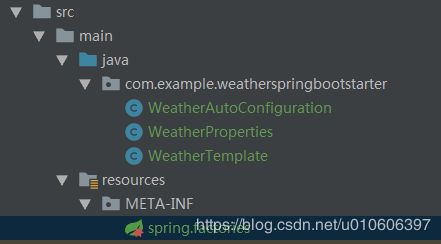spring boot 2源码系列(七)- 创建自己的starter
使用spring-boot的时候,若需要使用一些中间件,最简单直接的方式是导入starter,例如使用redis需要做以下两步:
1、添加spring-boot-starter-data-redis依赖
2、application.properties新增redis配置。
starter极大地简化了中间件的使用,方便开发者快速开发业务功能。starter依赖于spring的自动装配功能,学习了上一篇 spring boot 2源码系列(六)- 自动装配 之后,本文教大家创建一个自己的starter。
1、创建一个工程 weather-spring-boot-starter,pom.xml配置如下
4.0.0
org.springframework.boot
spring-boot-starter-parent
2.2.4.RELEASE
com.example
weather-spring-boot-starter
0.0.1
weather-spring-boot-starter
Demo project for Spring Boot
1.8
org.springframework.boot
spring-boot-starter
compile
只导入spring-boot-starter依赖即可。
2、新建WeatherProperties类,用于承载配置。
@ConfigurationProperties(prefix = "weather")
public class WeatherProperties {
private String type = "type默认值";
private String rate = "rate默认值";
public String getType() {
return type;
}
public void setType(String type) {
this.type = type;
}
public String getRate() {
return rate;
}
public void setRate(String rate) {
this.rate = rate;
}
}2.1 @ConfigurationProperties(prefix = "weather")的作用是将配置文件中以weather开头的属性绑定给WeatherProperties。
2.2 WeatherProperties的属性配置了默认值,如果使用者没有在application.properties配置weather.type、weather.rate,则使用默认值。
3、新建WeatherTemplate,实现我们想要的功能。WeatherTemplate构造函数接收WeatherProperties参数,以便能使用到配置文件。
public class WeatherTemplate {
private WeatherProperties weatherProperties;
public WeatherTemplate(WeatherProperties weatherProperties) {
this.weatherProperties = weatherProperties;
}
public void weatherPrint(){
System.out.println(String.format("执行自定义功能,type是:%s。rate是:%s", weatherProperties.getType(), weatherProperties.getRate()));
}
}
4、新建WeatherAutoConfiguration自动装配类
@Configuration
/**
* @EnableConfigurationProperties的作用是使WeatherProperties配置类生效
* @ConditionalOnProperty 配置了weather.enable=true的时候,本类生效
*/
@EnableConfigurationProperties(WeatherProperties.class)
@ConditionalOnProperty(name = "weather.enable", havingValue = "true")
public class WeatherAutoConfiguration {
@Autowired
private WeatherProperties weatherProperties;
/**
* @ConditionalOnMissingBean 如果ioc容器中没有WeatherTemplate,则本bean生效
*/
@Bean
@ConditionalOnMissingBean(WeatherTemplate.class)
public WeatherTemplate weatherService(){
return new WeatherTemplate(weatherProperties);
}
}5、新建resources/META-INF/spring.factories,填写如下配置,启动自动装配:
org.springframework.boot.autoconfigure.EnableAutoConfiguration=com.example.weatherspringbootstarter.WeatherAutoConfiguration
6、将weather-spring-boot-starter打成jar包。
weather-spring-boot-starter就完成了。使用weather-spring-boot-starter与使用其他starter一样,需要引入依赖,填写配置文件。
1、在其他项目中引入weather-spring-boot-starter
com.example
weather-spring-boot-starter
0.0.1
2、application.properties填写如下配置
weather.enable=true
weather.type=新类型值
#weather.rate=新比率值3、编写一个测试类测试
@SpringBootTest
public class WeatherStarterTest {
@Autowired
WeatherTemplate weatherTemplate;
@Test
void contextLoads() {
weatherTemplate.weatherPrint();
}
}
